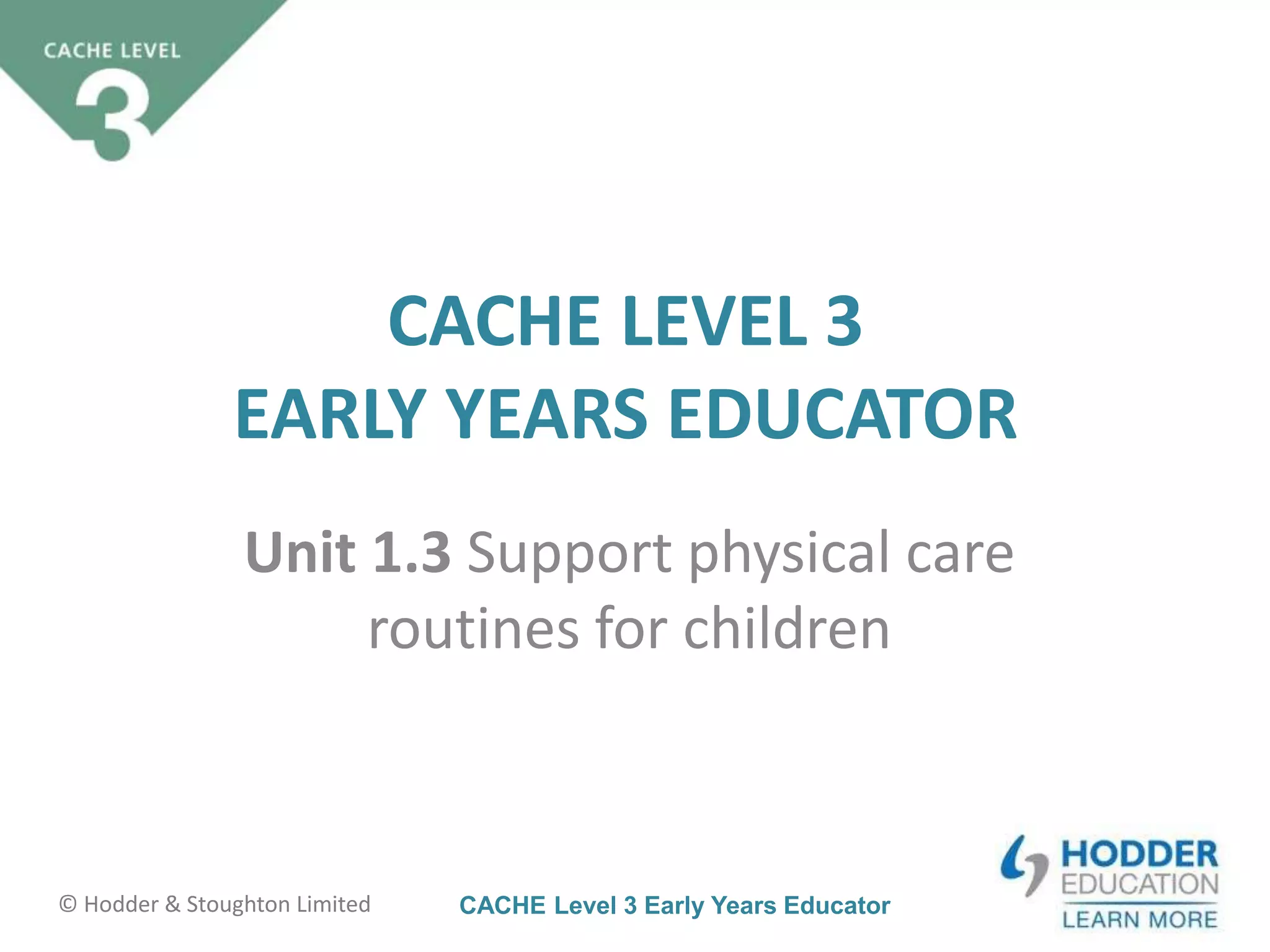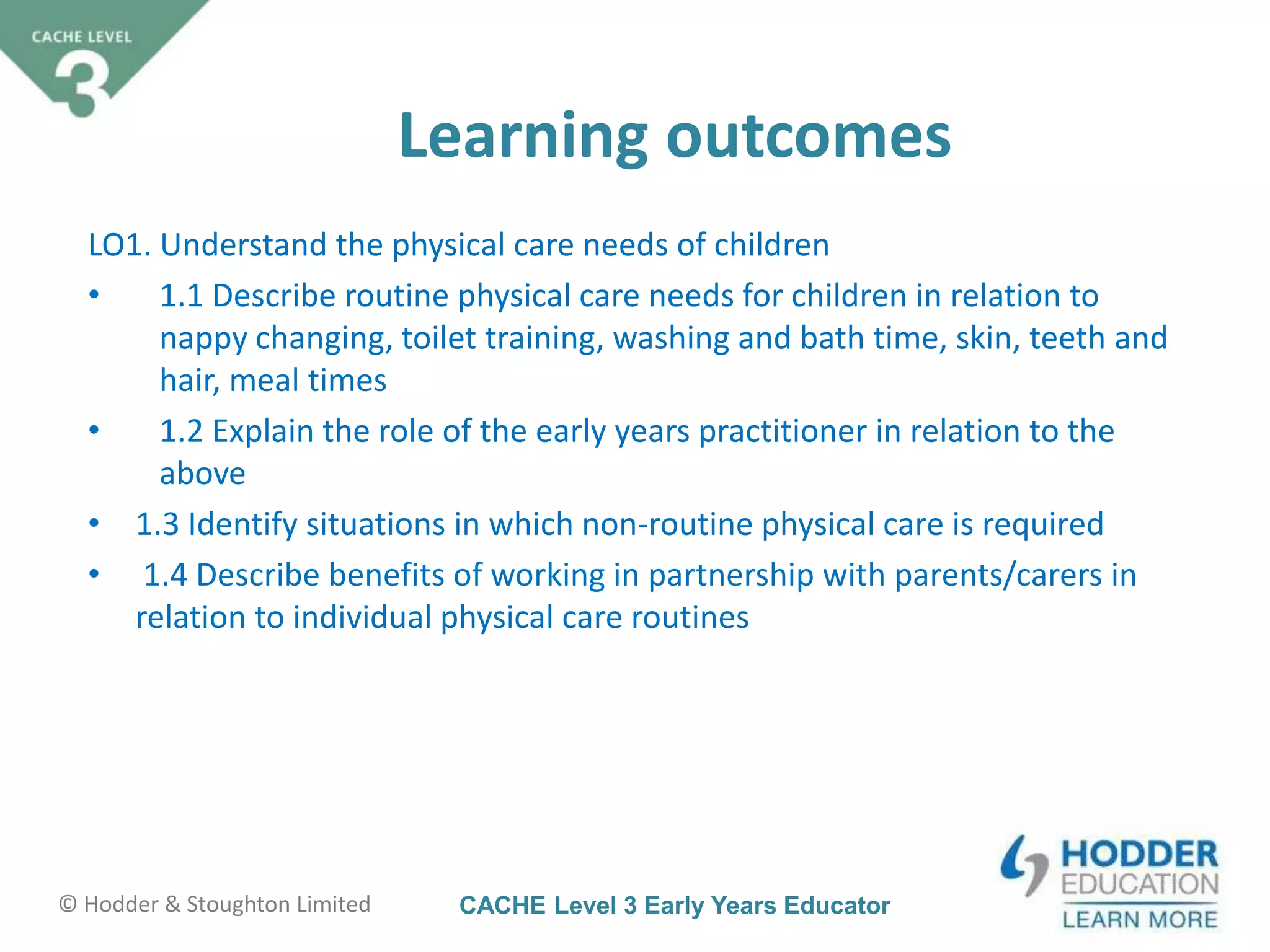The document discusses physical care routines for children in early years education settings. It covers routine care needs such as nappy changing, toilet training, bathing, and meal times. It also addresses non-routine care needs that may arise, like due to accidents or illness. The role of early years practitioners is to provide care that respects children's dignity while supporting their independence and development. It is important for practitioners to work closely with parents to ensure consistency between the setting's routines and those at home.


![CACHE Level 3 Early Years Educator© Hodder & Stoughton Limited
Starter activity
LO1. Understand the physical care needs of children [AC 1.1]
Time: 15 mins
• Write a sentence to provide a definition of the term ‘routine’.
• List all the physical care needs of children.
• Are some needs more relevant to different ages?
• Group the care needs into different age brackets.](https://image.slidesharecdn.com/u1-150904124606-lva1-app6891/75/U1-3-lesson1-lo1-3-2048.jpg)
![CACHE Level 3 Early Years Educator© Hodder & Stoughton Limited
LO1. Understand the physical care needs of children [AC 1.1]
• Routines should provide a predictable and well-ordered
environment, children know what to expect.
• Routines are comforting and provide regularity, especially for
babies as they enable them to adjust to their own body
rhythms.
• For toddlers, routines provide security and they are a way of
teaching children about how to look after themselves.
• The predictability of routines help to reduce anxiety and the
child can develop self control.
Why are routines important for children?](https://image.slidesharecdn.com/u1-150904124606-lva1-app6891/75/U1-3-lesson1-lo1-4-2048.jpg)
![CACHE Level 3 Early Years Educator© Hodder & Stoughton Limited
LO1. Understand the physical care needs of children [AC 1.1]
Routines should provide a predictable and well-ordered
environment.
• Nappy changing
Provides the opportunity for parents and practitioners to
bond with babies.
• Toilet training
Encourages children to develop independence.
• Washing and bath time
Shows children how to take care of themselves.
Why are routines important for children? (cont’d)](https://image.slidesharecdn.com/u1-150904124606-lva1-app6891/75/U1-3-lesson1-lo1-5-2048.jpg)
![CACHE Level 3 Early Years Educator© Hodder & Stoughton Limited
• Skin, teeth and hair
Provides the opportunity for children to be taught the
importance of self care and how to look after themselves
properly.
• Meal times
These are when children can learn to use tools properly and
have the opportunity to learn social skills.
• Sleep
They appreciate consistency and predictability and are more
likely to be relaxed and go to sleep more easily. Helps children
to set their own body clocks.
LO1. Understand the physical care needs of children [AC 1.1]
Why are routines important for children? (cont’d)](https://image.slidesharecdn.com/u1-150904124606-lva1-app6891/75/U1-3-lesson1-lo1-6-2048.jpg)
![CACHE Level 3 Early Years Educator© Hodder & Stoughton Limited
Classroom discussion activity
LO1. Understand the physical care needs of children [AC 1.1]
Time: 15 mins
In groups, discuss the routines in which you think a setting may have
and describe the routines that you have in place for the physical care
needs of children:
• Nappy changing
• Toilet training
• Washing and bath time
• Skin, teeth and hair
• Meal times
• Sleep.
Discuss similarities and differences to the approach in different
setting’s such as child-minder, Day Nursery, Pre-School.
Why do you think that the approach is different in some settings?](https://image.slidesharecdn.com/u1-150904124606-lva1-app6891/75/U1-3-lesson1-lo1-7-2048.jpg)
![CACHE Level 3 Early Years Educator© Hodder & Stoughton Limited
LO1. Understand the physical care needs of children [AC 1.2]
Many physical care needs involve intimate personal care. Practitioners
need to consider :
• How to provide respect and dignity
• The welfare of the child.
As well as the above, it is the practitioner’s role to educate the child, to
consider:
• The holistic development of the child – learning to be independent,
making their own choices
• Provide encouragement of independence and making informed
choices.
The role of the early years practitioner in providing for care
needs of children](https://image.slidesharecdn.com/u1-150904124606-lva1-app6891/75/U1-3-lesson1-lo1-8-2048.jpg)
![CACHE Level 3 Early Years Educator© Hodder & Stoughton Limited
Group activity
LO1. Understand the physical care needs of children [AC 1.2]
Time: 15 mins
In groups discuss how you can show respect and dignity when
you are nappy changing or toilet training a child.
Consider:
• What might the practitioner need to do?
• What should you be aware of?
• How can you encourage and reassure the child?
• What should you not do?](https://image.slidesharecdn.com/u1-150904124606-lva1-app6891/75/U1-3-lesson1-lo1-9-2048.jpg)
![CACHE Level 3 Early Years Educator© Hodder & Stoughton Limited
Pairs activity
LO1. Understand the physical care needs of children [AC 1.2]
Time: 15 mins
1. In pairs, discuss washing and bath time routines, care of skin,
teeth and hair and meal times.
• How can you make these routines fun?
• What are you teaching the children in each of these routines?
• What skills are they learning?
• How are they learning to care for themselves?
2. Look at the game cards provided for this session.
• Sort them into positive and negative experiences for the child.
• Explain all the reasons why you have categorised them as such.](https://image.slidesharecdn.com/u1-150904124606-lva1-app6891/75/U1-3-lesson1-lo1-10-2048.jpg)

![CACHE Level 3 Early Years Educator© Hodder & Stoughton Limited
LO1. Understand the physical care needs of children [AC 1.3]
• There will be occasions when the practitioner has to provide
physical care which is not part of a regular routine.
• Some examples of this would be when a child has an accident, an
asthma attack, an epileptic fit etc., or when a child is discovered to
have a contagious disease.
• It is important that the practitioner does not panic, but provides
comfort and reassurance to the child. The practitioner should know
who is first aid trained and seek assistance if necessary.
• In all cases it is important that the practitioner is aware of the
relevant setting policies and procedures, children with allergies and
knows that there is an emergency contact number.
Non-routine physical care](https://image.slidesharecdn.com/u1-150904124606-lva1-app6891/75/U1-3-lesson1-lo1-12-2048.jpg)
![CACHE Level 3 Early Years Educator© Hodder & Stoughton Limited
LO1. Understand the physical care needs of children [AC 1.4]
• It is vitally important that practitioners and parents work closely
together when devising care routines for children.
• Practitioners should consult the parents to find out how they plan
the routines at home and try to follow these as closely as possible
in the setting, to ensure continuity for the child.
• A good setting may have different routines for individual children,
for example, for a sleep routine some children may like to have
their feet gently tickled, others may prefer to be sung a lullaby,
while others may prefer to have their favourite cuddly toy with
them.
• The practitioner should discuss the routine with the parent in order
to help the child feel safe and secure.
The benefits of working in partnership with parents/carers in
relation to individual physical care routines](https://image.slidesharecdn.com/u1-150904124606-lva1-app6891/75/U1-3-lesson1-lo1-13-2048.jpg)
![CACHE Level 3 Early Years Educator© Hodder & Stoughton Limited
Independent research activity
LO1. Understand the physical care needs of children [AC 1.3]
Placement task
Find out who is first aid trained in your setting. Ask your setting if you can
have a copy of their policies and procedures which relate to non-routine
physical care.
These could include the following:
• Accident and incident record
• Child protection policy
• Procedure for safe disposal of nappies, aprons and gloves
• Fire safety procedure
• Health and safety policy
• Illness and injury policy
• Medication policy.
Having read the policies, write an explanation of how you would deal with a
child who has an asthma attack.](https://image.slidesharecdn.com/u1-150904124606-lva1-app6891/75/U1-3-lesson1-lo1-14-2048.jpg)
![CACHE Level 3 Early Years Educator© Hodder & Stoughton Limited
Reflection activity
LO1. Understand the physical care needs of children [AC 1.1, 1.2,
1.3]
Time: 15 mins
• When you start placement, list the children that you know
of who have allergies, asthma, epilepsy, diabetes or other
conditions. Use initials, not children’s real names.
• Do you know how to care for them if their condition
requires it?
• Consider all the other day-to-day routines, nappy changing,
toilet training etc.
• Do you know what stage each child is at and what their next
goals are?](https://image.slidesharecdn.com/u1-150904124606-lva1-app6891/75/U1-3-lesson1-lo1-15-2048.jpg)


![CACHE Level 3 Early Years Educator© Hodder & Stoughton Limited
Extension activity
LO1. Understand the physical care needs of children [AC 1.1, 1.2,
1.3]
Time: 15 mins
Daily routines
1. What is a routine?
2. Give an example of a routine.
3. Give three reasons why routines are important for children.
4. Describe what you would do for a skin, teeth and hair or bath
time routine for a young child.
5. What would theorists such as Bowlby, Skinner and Piaget
have to say about routines? Do their theories support the
use of routines in a child’s life? If so, how?](https://image.slidesharecdn.com/u1-150904124606-lva1-app6891/75/U1-3-lesson1-lo1-18-2048.jpg)